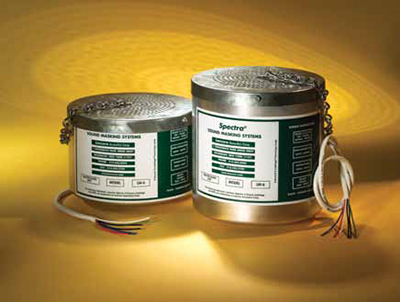Sound Masking Systems Open Up Productivity and Collaboration

The Lencore Spectra Sound Masking LM6-CVC unit operates as a central volume control from which global volume adjustments can be made for up to 50 main units and covering up to 33,000 square feet system-wide. For use in traditional plenum space when central volume control is required, the unit consists of an individual self-contained noise generator, audio amplifier, loud speaker in a damped metal enclosure, powered by 16/18 volts AC, is capable of driving one secondary model, and is available in both four and six-inch models.What if you could offer your next corporate client potential productivity gains of eight to 38 percent, job satisfaction increases of 125 to 174 percent, and reductions in stress up to 27 percent? Wouldn’t everyone involved be 100 percent for it?
Numerous independent studies have demonstrated the benefits of sound-masking systems, and an improved workplace and new installation opportunities should sound like a win-win. But the difficulty and cost of installing sound masking remains high, even as installers learn to work with architects and furniture designers for this expanding category.
Sound masking may seem like an obvious extension of SMB and large corporate enterprise AV, but not every installer is diving in. For some, confusion and confidence remain hindrances.
“In talking with installers who have yet to venture into this area of AV, they tell me they don’t understand how it works and feel they may not be qualified to properly install and tune masking systems,” said Steve Brooks, speech privacy support manager for Atlas Sound.
“More and more AV installers are getting into this space, but it is still a relatively niche product category,” continued Danny Barr, vice president of sales for Cambridge Sound. “Many integrators are naturally very focused on their core competencies and sound masking is a new concept for them. But they certainly have the skills and capabilities to embrace this easily.”
According to David Smith, head of marketing for Lencore, a best-in-class sound masking system offers a broad speaker portfolio and flexibility in system design, delivering speech privacy and comfort. Any system is able to achieve speech privacy by turning the volume up loud enough—a stark difference from a comfortable system, achieved by having a true broadband sound with both high and low frequencies, proper uniformity, and the ability to easily create and tune zones.
“Tremendous opportunity exists between AV installers and the sound masking market,” said Smith. “AV installers are experts at creating environments that work for their occupants. System design and connectivity, particularly on large, complex projects, are right in the AV installers’ wheelhouse, and the influencers or decision makers that the AV Installer maintains relations with are typically the same people deciding on sound masking within a space.”
A daily selection of the top stories for AV integrators, resellers and consultants. Sign up below.

When Spartan Stores added office space at its corporate headquarters in Grand Rapids, MI, it hired ASCOM Communications Contractors of Holland, MI to design a masking system that would allow its employees to focus amid the noise of conversations, as well as afford them privacy in those conversations. ASCOM used the Ashly Pema 4125.70 combination processor/four-channel amplifier to give Spartan Stores a reliable and cost-effective sound masking system. Vandermeer used SysTune to tailor the Pema 4250.70’s equalization curves to precisely match the prescribed sound masking frequency response, and installed 40 Atlas Sound M1000 loudspeakers above the suspended ceiling, facing up for more effective masking.“Typically the primary reasons more AV installers are not taking advantage of sound masking as an extension of their operations is the ‘Out of Sight, Out of Mind’ theory and the lack of understanding that they can dynamically control the entire office environment outside of the boardroom,” added Smith. “’Out of Sight, Out of Mind’ is the thought process in the sound masking world that if you can’t see it then it is difficult to sell. The consumable in sound masking is the sound—nothing more. Unlike digital displays and microphones, sound is untouchable.
“But, what is truly missed is the realization that sound masking, typically, is employed throughout the entire building and touches every employee. Sound masking, when done right, affects the space by making it more comfortable and productive for any business’ greatest asset: its people.”
Many architectural elements—floor coverings, lights, and the reflectivity of ceiling, for example—require advanced acoustical coordination, and in most cases, installation and fine-tuning of the system will require a trained acoustical engineer.
“It is important that as a group, architects and interior designers understand the acoustic challenges that their clients may face,” said Barr. “Furniture manufacturers have not yet adopted this technology within their furniture offerings, but their independent dealers may often include sound masking solutions as part of their overall offering to a client.”
“The charge of the architect and designer is to provide an environment that meets the criteria of the business objective,” said Lencore’s Smith. “This can be different by employer or industry type, but at the heart of every facility should be productivity.”
Smith points toward current design trends which include more collaborative spaces with lower privacy partitions, more open areas, more daylighting, more glass—all at an economical price tag.
“These same trends are eliminating many of the absorptive materials such as acoustical ceiling tile, carpet, and fabric partitions all the while introducing more hard surfaces, such as glass and metals, which reflect sound,” added Smith. “The trends are creating more opportunity for sound masking because it is one of the only solutions that become available.”
Steve Brooks of Atlas Sound sees more partnerships on the horizon, as more people become aware of the benefits of sound masking.
“I see more and more furniture companies ‘partnering’ with masking equipment manufacturers as part of a package to offer their customers,” Brooks said. “I am not seeing much in the way of architects asking for assistance or information from Atlas Sound at this time, though I foresee this changing in the future. More people [will] become aware of the benefits of sound masking, with open office plans becoming more ‘open’, lowering cubicle dividers or doing away with them all together.”
“Most of our engagement on projects, though, does come from and through our channel partners,” Barr added. “Because this is still a fairly new category we continue to expand our channel at close to 30 percent per year, so we believe there are a lot of new clients in the marketplace looking for solutions.”
Smith noted that sound masking has transitioned from a luxury item to a commodity over the last decade, with the category finding footing in healthcare and educational institutions.
“Sound masking system design, installation, tuning, and balancing are not overly complex to learn,” said Smith. “More partnerships should be on the horizon but it will be with those AV installers who understand how sound masking can become an extension of their business and only offer Class A systems without compromise. AV providers who understand how to provide best in class systems and deliver the greatest service to existing and new clients will always survive.”
Derek Dellinger is the online editor of SCN and Residential Systems.
